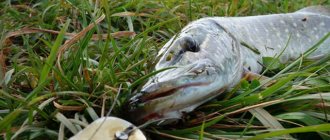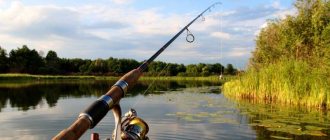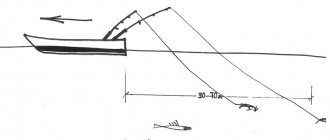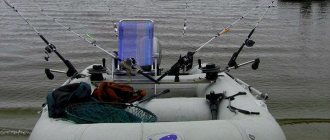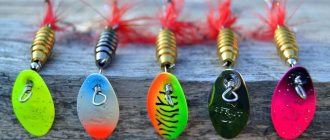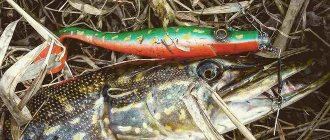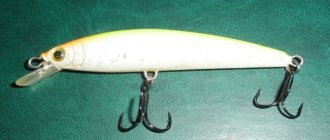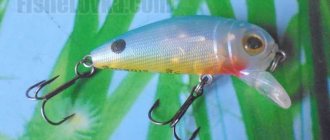How to choose a wobbler for trolling for pike
When purchasing a wobbler for trolling for pike, you should pay attention to the following characteristics:
- Size. To catch pike by trolling, preference should be given to larger wobblers (from eight to twenty centimeters). At the same time, the fisherman should know that only large pike will be caught with such baits. To catch small pike, medium-sized wobblers (from four to eight centimeters) should be used.
- Immersion depth. A wobbler for pike should have a diving depth of two meters, since it, as a rule, swims at great depths and in underwater holes. In addition, the fisherman can independently control the diving depth of the bait thanks to the speed of the boat: the faster it swims, the deeper the wobbler sinks.
- Color. The most effective colors of wobblers for pike are natural green and reddish. In addition, if the fishing takes place in muddy water or the weather is too cloudy, then in this case it is recommended to use brightly colored baits (so-called acid baits) so that the pike can notice them under such conditions.
- Noise. It is advisable that a wobbler for trolling have built-in noise functions. Thanks to them, it will attract pike even more. In addition, the vibration that the bait will emit when retrieving will also be useful.
- A game. This criterion is one of the main ones for a high-quality wobbler. He should have a bright active game even with slow wiring. If the wobbler does not have a good enough action, then its effectiveness decreases several times and the pike simply will not pay attention to it.
- Form . It is recommended to select those wobblers that will be similar to the fish that pike usually feed on: gudgeon, bleak, small crucian carp and dace.
Depending on the season, fishing wobblers for pike has the following features:
- If pike fishing occurs in the spring season, then you should use sinking wobblers and suspenders, since the pike at this time still swims at great depths and only when the water warms up a little will it begin to reach shallower areas of reservoirs. In addition, you should know that the best time to catch pike in the spring is the first two weeks after its spawning (late March - early April). It is then that the pike has a post-spawning glutton and actively bites on most baits.
- If pike fishing occurs in the summer season, then it is best to use floating wobblers, which can freely pass over the layer of growing algae and attract the pike that swims underneath them. As a rule, in summer pike prefers to swim in shaded areas of reservoirs to protect themselves from excessive heat.
- In autumn, pike begins to feed more intensively in order to gain as much strength as possible before winter and gradually goes deeper. Anglers should take this fact into account and use sinking models of wobblers that could be immersed in water to a depth of more than five meters.
- To catch pike in winter, it is best to use floating wobblers, which can dive no more than three meters deep. Usually, during this period the pike is not very active, but young pike can still be caught.
Where to look
Fishing for pike in the autumn is always successful, the main thing is to know some of the search features and be able to select bait. Based on the already studied characteristics of the behavior of the predator during this period, it is worth understanding that the collection of gear should be taken especially responsibly.
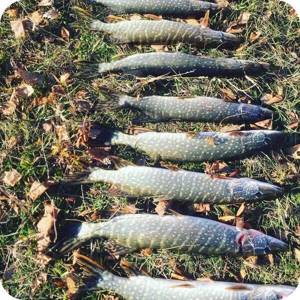
Experienced anglers can easily determine where to look for pike in October based on weather conditions; the cooler the water, the deeper the fish go. It increasingly moves away from the shore edges and practically never returns here; as a result, there is nothing to do on large bodies of water without a watercraft. But in this case the tackle comes with its own characteristics.
| tackle component | characteristics |
| rod blank | length 2.1-2.4 m. casting test 10-40 g, preference should be given to carbon options |
| coil | spool size no less than 3000, number of bearings from 4, gear ratio 5.2:1 |
| the basis | The best option is considered to be a cord with a thickness of 0.18-0.22 mm; it is possible to use monofilament line with a cross-section of 0.25 mm |
| accessories | swivels, carabiners, and winding rings are of excellent quality so as not to miss an aggressive catch of a decent size |
With such uniforms, searches are carried out in promising places, and these are:
channel edges
way out of the snag
exits from wintering pits
In warm, low-wind weather, you can try fishing in the middle layers of water in a reservoir; small fish often come out there to bask, followed by pike. In small bodies of water, where there is sufficient depth immediately near the shore, you can try short casts.
Fishing gear
For trolling for pike, you should use the following gear:
- Fishing rod. It must be very strong, since trolling is the most dangerous thing for rods and often causes them to be overloaded and broken. The best length for a spinning fishing rod is two and a half meters. If the spinning rod is larger, then such tackle will not be very practical and convenient for landing caught pike. The test rod must be at least two hundred grams, and its quality is made of fiberglass.
- Fishing line. For trolling pike, it is recommended to use braided line with a diameter of 0.3 mm. Monoline should not be used, since pike can bite through it without much difficulty.
- Leashes. Their length must be at least thirty centimeters. As for the material, it is advisable to make leashes from metal or thick braid.
- Hooks. To catch pike, you should use hooks with sizes from four to ten.
- Reel _ The best ones for trolling pike are considered to be spinning reels with a baitrunner (with a spool size of 3000 to 3500) or multiplier reels. The main thing is that the reels are made of high-quality materials and contain sufficient footage of fishing line (more than sixty meters).
Lures

Most often used for trolling fishing:
- wobblers;
- oscillating spoons;
- silicone baits.
Also suitable for this kind of fishing are spinners and rigs with dead fish , but they are used infrequently.
are rightfully considered the best bait . Each model has a certain immersion depth , making fishing as convenient and effective . You can also use spoons and silicone baits to work in the desired horizon where the fish are, but this is much more difficult to do.
The 10 best wobblers for trolling for pike are:
- Halco Sorcerer;
- Salmo Hornet;
- Bomber Deep Long A;
- Rapala Shad Rap;
- Rapala Deep Tail Dancer;
- Rapala Clackin' Rap;
- Nils Master Haka Deep Diving;
- Yo-Zuri Hardcore;
- Yo-Zuri 3D Crank;
- Strike Pro Flap Jack.
Oscillating spoons, when presented correctly, can catch wobblers, but lowering them to the desired depth can be difficult. To do this, you need to use additional equipment elements, such as sinkers, sinkers and downriggers . In the lines of different manufacturers there are special models designed for trolling; you can also use regular spinning lures.
Silicone baits mounted on a jig head are also used for trolling pike . Models that have an active game of their own are suitable for this. There is no need to waste time when choosing them - the best results can be achieved by fishing with baits at least 15 cm long.
Technique for catching pike with wobblers when trolling
The technique of catching pike using wobblers by trolling includes the following components:
- Finding a suitable place for fishing. The most common habitats of pike are:
- Deep dumps, not far from the current.
- Deep underwater holes and places that are located nearby.
- Areas near the coast.
- Places near sunken trees and bushes.
- Areas near reed growth.
- Places near driftwood and aquatic vegetation (water lilies).
- Next, you should cast the fishing line with a wobbler to a depth (up to ten meters). At the same time, the essence of trolling for pike provides that the catch will take place not from the shore, but from a boat. The boat itself must gradually pick up speed so that the bait moves near the bottom of the reservoir. Pike do not like noise very much, so you need to try to fish as quietly as possible so as not to scare it.
- The wobbler should be positioned in such a way that it can touch the bottom and create a cloudy cloud. Also, the angler must control the depth and observe all turns so that the wobbler does not disrupt its performance.
- The speed of moving the bait to the pike should not be too fast.
- A pike bite can be seen by the tip of the fishing rod, which begins to twitch. After this, you should stop the boat and, holding the fishing rod at an angle of fifty degrees, begin to quickly wind the line onto the reel.
- Slowly the catch must be brought to the boat. In this case, it is recommended not to immediately fish out the pike, but to exhaust it so that it loses its strength and stops resisting strongly. All its jerks must be sharply “extinguished” with a fishing rod, making retaliatory jerks.
Night trolling fishing has the following features:
- For night fishing, you should not use wobblers that have red or yellow colors, since the pike simply will not notice them. It is better to use baits with a blue or green color. In addition, it is desirable that wobblers have luminous pigments.
- Wobblers for use at night must have excellent fast action, since this is what the pike immediately turns its attention to.
- Pike swim to the depths at night, so you need to look for it there.
Pike trolling gear
Content
Trolling is a method of catching predatory fish using artificial and natural baits towed behind a motorized boat. The best results are obtained by fishing for pike in the fall, when biting of trophy specimens is most likely.
Due to its specific nature, trolling fishing requires special gear. The main requirement for them is strength.
This is explained by the following reasons:
- The drag of large baits, especially deep wobblers, is very high, and the tackle must ensure their flawless operation. This is especially important when trolling pike in the fall, when you use bait of the maximum size;
- when hooked, critical loads arise, because stopping the boat instantly is impossible;
- Trolling is aimed primarily at catching large fish, the resistance of which increases due to the movement of the boat.

Taking into account the above requirements, it is advisable to equip the gear as follows:
- The rod is a heavy class with a casting weight of 30 g, a length from 1.8 to 3.2 m and a fast or medium action. The most suitable material for a trolling rod is fiberglass. Rods are well suited for jerk fishing - the sizes of baits and trophies, and therefore the load on the tackle, are comparable.
- The reel is a multiplier, corresponding to the class of the rod. You can also use powerful spinning reels with gear ratios up to 4.7:1 and sizes from 3500 according to the Shimano/DAIWA classification.
- The fishing line is braided with a breaking load of 7 kg (often more, depending on the fishing conditions in a particular body of water). A metal leash with a length of 30 cm is required.
- Accessories - snap hooks, winding rings, swivels, etc. - must be of high quality and match the strength of the other elements of the gear.
In addition to a fishing rod and bait, it is highly desirable to have an echo sounder and a navigator. The first is used to study the bottom topography in search of suitable places, and the second is used to remember them - in the vastness of reservoirs or large lakes, it can be difficult to find the right hole or underwater hill. The navigator can also be useful for returning to base when trolling pike on the river, especially in the lower reaches - it’s easy to get lost among the many channels in the floodplains, and thickets of reeds or reeds limit visibility, turning the water area into a labyrinth.
Read more
How to catch grayling with fly fishing?
Blitz tips
- When trolling for pike, you should always use a leash. The best thing for this is a regular guitar string or metal leashes that the pike cannot bite through.
- The fisherman must always control how the wobbler behaves in the water, because if it does not move correctly, the fishing result may be zero.
- Pike pays most attention to the game and movements of the bait, and not to its color and similarity to a live fish, so the angler should pay the most attention to these criteria;
Place and time of fishing

They hunt for pike from the beginning of the open water fishing season until late autumn. On hot days it is less active, so it will be more difficult to catch fish. In summer, you should choose cloudy and windy days for trolling.
The best time to hunt for such prey is considered to be autumn. After all, it is then that the fish begins to actively feed and scour the reservoir in search of prey. Best suited for trolling fishing:
- Reservoirs.
- Big rivers.
- Large lakes.
You need to choose a place where large schools of peaceful fish will gather, and this is the main delicacy of pike. It is better to give preference to undamaged reservoirs with a depth of two to eight meters.
The boat is directed far from the shore to reduce the chance of getting caught on snags or getting tangled in seaweed. Medium-sized predators should be looked for in backwaters where there is practically no vegetation and the depth reaches 4-5 meters.
The best places for trolling for pike are:
- edges at the mouth of the river;
- deepening of bottom reliefs;
- turns of the river bed;
- deep holes with slow currents.
Fishing tactics
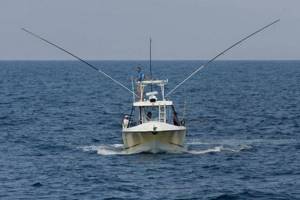
1. Fishing begins with the preparation of gear:
- they are loaded with baits;
- adjust according to fishing conditions.
2. Casting is done in a fan-shaped manner.
3. The forms are installed in holders, using deepeners if necessary.
4. Towing of baits is carried out at specified horizons, using an echo sounder.
5. Fishing begins from the deepest zones, moving slowly and using heavy baits.
6. Then they pass the dump 3-4 times, approaching from the side of clear water.
7. Next they walk along the thickets, trying to avoid snags.
8. When biting, as a rule, the prey is caught on its own.
9. Remove the stick from the holder and bring the fish to the side.
A careful approach to purchasing tackle and equipment for trolling, the correct choice of location and competent use of fishing tactics will not only ensure a successful fishing result, but will also enable the angler to fully enjoy the process itself, get a lot of unforgettable impressions and maximum pleasure.
fishing line
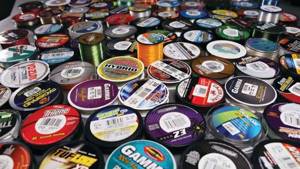
For trolling fishing, a high-quality braided line is usually chosen:
- it has good contact with the bait;
- has twice the strength of monofilament.
For high-speed trolling on large bodies of water, the braided line is supplemented with a shock leader made of monofilament to eliminate the shortcomings of the line:
- poor elongation and inability to completely absorb production jerks;
- the possibility of rubbing the rings and the braid itself.
For rigid fast-action gear, use monofilament fishing line, which has good elongation, excellent springiness and will not tear the bait out of the mouth of the prey. The thickness of the fishing line is selected in accordance with the structure of the form:
- for the average one take 0.1-0.2 mm braid, and 0.3-0.4 mm monofilament;
- for heavy - 0.2 mm and 0.3-0.5 mm.
The breaking load limits must also correspond to those recommended for this fishing rod:
- if the upper value is exceeded, the stick may break;
- if the strength is too low, frequent breaks of the monofilament or cord are possible.
Considering the possibility of large pike biting, it is worth adding a metal leash about 0.5 m long to the equipment.
You may be interested in: Fishing tackle
Motors
To plane a boat with 30 kilograms of weight, 1 hp is needed . Let's say the boat is 4.2 meters long and weighs 100 kilograms.
It requires an engine with at least 12 hp. It’s good if there is a small power reserve - 3 hp. The maximum for an inflatable boat is an engine with 30 hp.
You don't need that much power for trolling. More than 15 hp not recommended : if the motor is more powerful, over time the structure of the punt will become deformed, because when the throttle is opened strongly, the bottom of the boat is subjected to strong impacts.
The optimal motor power for a hull boat (for example, Voronezh) is 25 hp. It is more difficult for it to go on plane than an inflatable one.
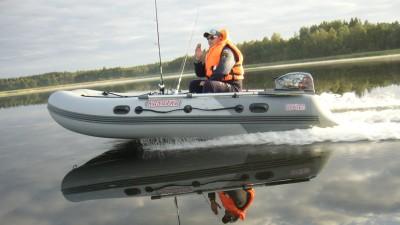
Power is not an indicator of all the characteristics of a trolling outboard motor. For example, Tohatsu-9.8, having the same power as Mercury-10, is very different from it in terms of speed and thrust, since the engines have different volumes. M-10 and M-15 are the same in volume, but their difference in power is 1.5 times. By the way, this difference has practically no effect on the price.
Motor with a power of 15 hp. costs approximately 1800 - 2200 US dollars. Price of an engine with a power of 25 hp. is in the range from 2400 to 2600 US dollars.
The leaders on the market now are motors made in Japan and the USA. Most of them have a warranty of 2 thousand hours. During this time, the car would have traveled 120 thousand kilometers, and for a boat such a resource means many years of use (rarely does anyone spend as much time at the tiller as behind the wheel of a car).
When choosing a specific model, pay attention to the following points:
- how much does the engine weigh?
- is there a service;
- Is the interface user-friendly?
- Does the dealer have spare parts in stock to repair the motor (if something fails and you need to order a part, the delivery time may be long, and free time for trolling fishing may be lost while waiting for the part).
Gasoline or electric?
If you use an electric motor on a fast-flowing river, the battery will quickly run out. An electric motor is a more suitable option for calm bodies of water.
Trolling on a two-stroke motor
It is believed that a 4-stroke motor is more suitable for trolling than a 2-stroke. The fact is that a 4-stroke engine is more environmentally friendly. In a 2-stroke engine, exhaust gases are forced out of the cylinder with a fresh mixture. It is impossible to completely displace the spent mixture without getting fresh mixture into the exhaust window.
However, there are also positive aspects in operating a 2-stroke engine (by the way, there are no less of them than negative ones): its power stroke is more frequent, therefore, with the same engine volume as a 4-stroke engine, it has more power. In addition, a 2-stroke motor is lighter and easier to maintain.
Boat speed when trolling
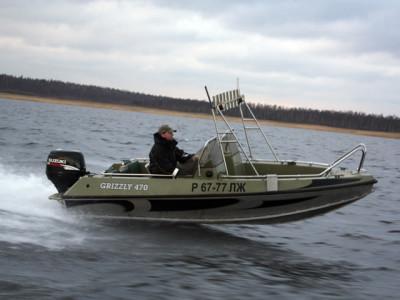
Often, a predator rushes at the bait when the speed of its retrieval increases. Some wobblers oscillate intensely at low boat speeds, while others begin to oscillate only when the speed increases.
Details in our articles: which wobblers are best to use for trolling fishing for catfish, pike perch and pike.
The boat's speed of 2.5 kilometers per hour allows you to catch fish in cold water: under this condition, the predator is sluggish and has no desire to chase fast-moving prey. The low speed also makes it possible to slowly move the bait over the river hole. The minimum speed of a boat depends on its resistance.
